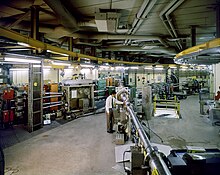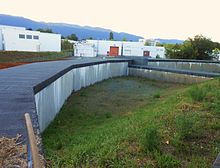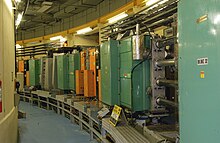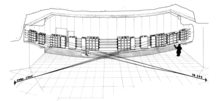Proton Synchrotron Booster
| CERN's accelerator complex | |
|---|---|
| List of the current particle accelerators at CERN |
|
| Linac 2 | Accelerates protons |
| Linac 3 | Accelerates ions |
| Linac 4 | Accelerates negative hydrogen ions |
| AD | Brakes antiprotons |
| LHC | Collides protons or heavy ions |
| LEIR | Accelerates lead ions |
| PSB | Accelerates protons or ions |
| PS | Mainly accelerates protons |
| PLC | Accelerates protons, among other things |
The Proton Synchrotron Booster ( PSB ) is a synchrotron - particle accelerator at CERN . It was put into operation in 1972 and consists of four jet pipes, one on top of the other, each forming a ring with a 25 m radius. The Proton Synchrotron Booster is the pre-accelerator of the larger Proton Synchrotron (PS). Protons are conducted into the PSB with an energy of 50 M eV , where they are accelerated to 1.4 GeV and then forwarded into the proton synchrotron. By building the PSB, the number of protons in the PS could be increased sixfold.
history
1964 - 1968: planning and start of construction
Before the PSB went into operation in 1972, the protons were delivered directly from the Linac 1 linear accelerator to the Proton Synchrotron (PS), where they were accelerated from 50 MeV to 25 GeV. The proton intensities that could be achieved in this way were 1.6 · 10 12 protons per pulse. However, the newly developed experiments (mainly in the context of the intersecting storage rings ) required significantly higher numbers of protons of 10 13 protons per pulse. This should be implemented by a preliminary stage in the acceleration process, which could increase the energy of the protons even before entering the PS.
In this context, various proposals for the planned so-called "PS injector" were discussed. a. another linear accelerator or five intersecting circles in the shape of the Olympic rings . Ultimately, the choice fell on a design made up of four synchrotron rings arranged one above the other with a radius of 25 meters. This construction, which had been proposed in 1964, made it possible to increase the number of protons to the desired 10 13 protons per pulse (2.5 · 10 12 per ring). Through further improvements, a total of 4.25 · 10 13 protons per pulse was finally fed in by the PSB.
The estimated total cost of the renovation work was CHF 69.5 million (1968 prices). More than half of this was earmarked for the PSB building project, which began in 1968.
1972 - 1974: Commissioning
On May 1, 1972, the first protons were accelerated in the PSB; three and a half weeks later, on May 26, 1972, the maximum energy of 800 MeV was reached.
The intermediate goal of 5.2 · 10 12 protons per pulse was achieved in October 1973. Overall, it took about two years until the planned intensity of 10 13 protons per pulse was reached.
1973 - 1978: Update to the Linac 2
The linear accelerator Linac 1, at that time CERN's main source of protons, could no longer keep up with the technical advances of the other machines in the accelerator complex over the years. Therefore, in 1963, it was decided to build a new linear accelerator, which would later be called Linac 2. This new accelerator should deliver protons with the same energy as before (50MeV), but with a longer pulse duration of 200 μs and a higher current of 150 mA. Construction of the Linac 2 began in December 1973 and was completed in 1978.
Linac 2 continued to operate until 1992 and was used as a source of light ions.
1988: Upgrade to 1 GeV
After more than ten years in operation, the constant increase in beam intensity required a corresponding increase in the output energy of the PSB. With only minor changes to the machine, the PSB was therefore upgraded to 1 GeV in 1988.
1980s - 2003: Acceleration of Ions
From the beginning of the 1980s, the PSB was also used to accelerate deuterium , helium , sulfur and oxygen ions, which were fed into the PSB by the Linac 1 linear accelerator at the time. With the commissioning of the Linac 3 linear accelerator, which was specially designed for ions, heavier ions such as indium or lead were also accelerated in the PSB . The PSB has not been used for this since 2006, as ions are now fed into the PS from the Linac 3 via the Low Energy Ion Ring (LEIR).
1992: Connection to the ISOLDE experiment
From 1989 to 1992 the device for generating radioactive ion beams pulled ISEULT ( I sotope S eparator O n L ine DE vice) for PSB to which since the 1960s by the former Synchro cyclotron was fed (SC) with accelerated to 600 MeV protons . The PS was no longer the sole recipient of the protons accelerated by the PSB.
Today ISOLDE uses the proton beam of the PSB with up to 1.4 GeV to generate the radioactive ion beams.
1999: Preparation for the LHC and upgrade to 1.4 GeV
The planned Large Hadron Collider required a further upgrade of the PSB to 1.4 GeV. This implied major improvements to the machine than was the case with the previous upgrade to 1 GeV, as at that point the limits of the original design parameters of the PSB were exhausted. The renovation work was completed in 2000.
2010 - 2026: Future upgrades for the HL-HLC
In 2010 another major upgrade of the LHC was decided: the High Luminosity Large Hadron Collider (HL-LHC).
The significantly higher beam intensities required require the output energy of the PSB to be increased again to 2 GeV. Over the next few years this will be achieved by replacing and renewing many key components of the PSB, e.g. B. the main power supply, the radio frequency system, the connection to the PS and the cooling system implemented.
In addition, the energy fed into the PSB will be increased: Linac 4, which is currently being commissioned, is supposed to deliver energies of 160 MeV and will replace Linac 2 in 2020.
By using negative hydrogen ions (H - ) instead of protons (H + ), Linac 4 will be able to provide the LHC with a significantly better quality proton beam. A film at the injection point for the electrons of the PSB is H - ions remove only the protons fly further. These are accumulated as so-called "beam bunches" in the four rings of the PSB, accelerated by it and passed on along CERN's accelerator infrastructure.
Infrastructure and operations
The PSB is part of the complex accelerator infrastructure at CERN. At the time of its construction, CERN's main campus in Meyrin had just been enlarged and was now not only on Swiss but also on French soil. The center of the PSB rings is exactly on the border between Switzerland and France. Different regulations apply in both countries, which concern the approval of buildings at the national border. Therefore it was decided to build the main infrastructure of the PSB underground. The only infrastructure visible above the earth can be found on the Swiss side. The PSB consists of four rings stacked on top of each other with a radius of 25 meters. Each of these rings consists of 16 periods, each of which consists of two dipole magnets and a focusing structure of three quadruple magnets (focusing, defocusing, focusing).
The proton pulse of the linear accelerator is split vertically into six partial beams with the help of sequentially pulsed magnets, the first and last corresponding to the rising or falling flank of the proton pulse and not being used. The four central beams are then guided into the individual vertically stacked beam tubes by means of additional magnets. To increase the number of protons per packet or the number of proton packets per ring, the process is repeated several times. In the past, five packages per ring were filled and now usually one or two packages, with two to more than ten repetitions per package.
After the 1.2 second acceleration and additional spatial synchronization of the proton packets - these are then exactly one above the other in all beam pipes - they are decoupled one after the other with the help of special pulsed magnets so that the proton packets of a ring are extracted per revolution. The total decoupling of four rings takes place at 1.4 GeV within 2291.2 ns (four times the orbit time of 572.8 ns). Depending on the requirements for the number of packets and the sequence, only individual rings are used for acceleration or more than four proton packets from two fillings with one proton pack per ring are fed into the PS (e.g. for the LHC 4 + 2 packets).
In 2017, 1.51 · 10 20 protons were accelerated in the PSB. 61.45% of this was delivered to ISOLDE, only a small part of 0.084% is used by the LHC.
literature
- Michael Benedikt (Ed.) U. a .: LHC design report. Volume III: The Injector Chain. CERN, Geneva 2004, ISBN 92-9083-239-8 ( online ; PDF).
- K. Hanke: Past and present operation of the CERN PS Booster. (PDF; 7.7 MB) In: International Journal of Modern Physics A. Vol. 28, No. 13, 2013, pp. 1330019 (1-25), doi : 10.1142 / S0217751X13300196 .
Web links
- PSB machine layout. By Sven De Man, CERN AB-ABP Group, 2008.
- Proton Synchrotron Booster (PSB). On lhc-facts.ch.
- Photos from PSB. On the CERN Document Server (CERN Photo Lab).
Individual evidence
- ↑ a b c d e K. Hanke: Past and present operation of the CERN PS Booster. ( Memento of the original from June 25, 2014 in the Internet Archive ) Info: The archive link was inserted automatically and has not yet been checked. Please check the original and archive link according to the instructions and then remove this notice. (PDF; 7.7 MB) In: International Journal of Modern Physics A. Vol. 28, No. 13, 2013, pp. 1330019 (1-25), doi : 10.1142 / S0217751X13300196 .
- ^ A b "S Gilardoni, D. Mangluki: Fifty years of the CERN Proton Synchrotron Vol. II (2013)" Retrieved July 10, 2018
- ^ A b " The Second Stage CMS Improvement Study: 800 MeV Booster Synchrotron (1967)" Retrieved July 10, 2018
- ↑ "E. Boltezer et al .: The New CERN 50-MeV LINAC (1979)" Retrieved on 10 July 2018
- ↑ "CERN Annual Report 1988 Vol. II (french), page 104" Retrieved July 11, 2018
- ↑ "Belochitskii et al .: LEIR-PLC (2006) " Retrieved on July 11, 2018
- ↑ "CERN ISOLDE Website: History" Retrieved July 10, 2018
- ↑ ISOLDE - History. ISOLDE - The Radioactive Ion Beam Facility, accessed August 3, 2013.
- ^ "C. Carli: Proceedings of the Chamonix 2010 Workshop on LHC Performance ". Accessed July 10, 2018
- ↑ "PBS machine overview: Sketch of period 1" Retrieved July 10, 2018
- ↑ Michael Benedikt (ed.) U. a .: LHC design report. Volume III: The Injector Chain. CERN, Geneva 2004, ISBN 92-9083-239-8 , pp. 45-48 ( online ; PDF).
- ↑ "CERN Annual Report 2017, page 23". Accessed July 10, 2018




